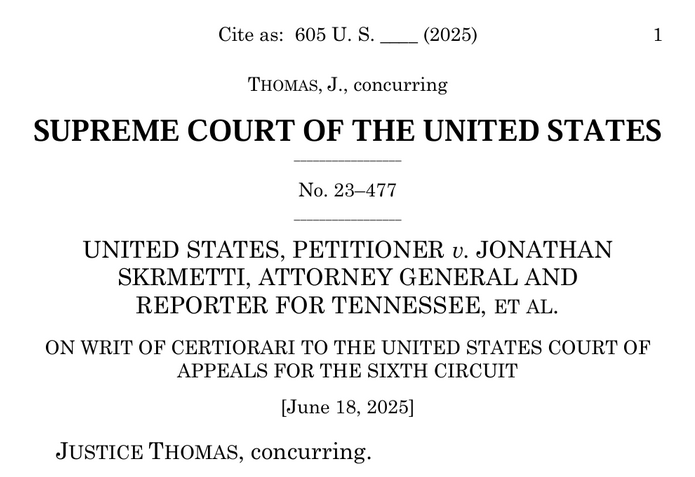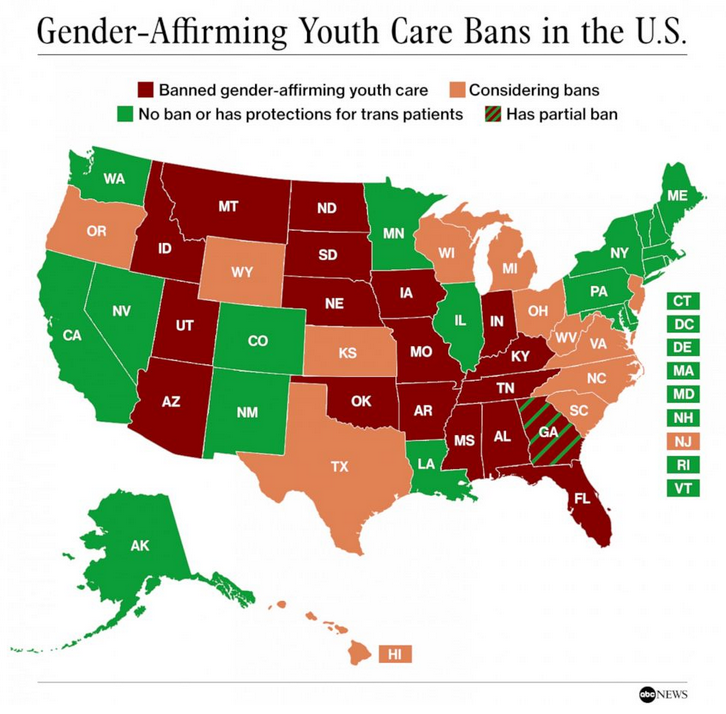United States v. Skrmetti: What SCOTUS Did (and Didn’t) Say
- J.M. Macasieb
- Sep 5
- 6 min read
The Supreme Court ruled 6-3 in favor of the State of Tennessee in United States v. Skrmetti, upholding the state’s law that prohibits medical gender transition procedures for minors. This landmark case was a major victory in the fight to protect children and a reaffirmation of constitutional restraint. This Skrmetti decision affirms that, even in an era of cultural intensity, the Constitution remains steadfast in its principles. The Court declined to create a new protected class or expand judicial power, leaving authority over controversial medical procedures for minors to the democratic process.
At the heart of the decision is the Court’s recognition that the State of Tennessee has a legitimate and compelling interest in protecting children from undergoing experimental medical interventions. The majority acknowledged that gender transition procedures, including puberty blockers, cross-sex hormones, and surgeries, carry significant risks and remain the subject of ongoing medical debate. As Chief Justice Roberts wrote, “That medical experts are still debating such issues serves only to highlight the propriety of allowing the states to decide for themselves how to proceed. A state is free to move cautiously while doctors and the scientific community work out their differences.”

Photo: Gays Against Groomers
SCOTUS Decision
The decision has generated strong reactions, but much of the commentary has misunderstood what the court said, and what it did not say. What follows is a clear breakdown of the majority opinion and its implications for the future. Tennessee’s law, known as SB1, prohibits medical providers from administering puberty blockers, cross-sex hormones, or performing surgeries for gender transition in individuals under the age of 18. It does not ban those same treatments when used to treat other conditions, nor does it apply to adults.
Three trans-identified minors, their parents, and a physician challenged SB1 in federal court. They argued that it violated the Equal Protection Clause of the Fourteenth Amendment by discriminating based on sex and transgender status. The Biden administration joined the suit, backing their claims. The Supreme Court rejected their argument. Writing for the majority, Chief Justice John Roberts held that SB1 does not violate the Constitution, as it does not classify based on sex or transgender status. Instead, the law classifies based on age and medical purpose, which are not suspect categories under the Court’s precedent. Therefore, the law was reviewed under the most lenient standard of judicial review: rational basis. Under that standard, a law is upheld so long as it is reasonably related to a legitimate government interest.

Photo: Supreme Court of the United States
Rational Basis
Rational basis review is the default level of scrutiny applied by courts when evaluating most laws under the Equal Protection Clause. It simply asks whether the law is reasonably related to a legitimate government objective. This standard does not require the government to prove the law is perfect or the best possible solutions—only that it is not arbitrary or irrational. Unless a law targets a suspect class (like race or sex) or burdens a fundamental right, rational basis is usually all that is required.
Roberts emphasized that courts do not second-guess legislatures unless a law targets a fundamental right or a protected class. SB1 applies equally to all minors, regardless of their sex or gender identity. That neutrality means that heightened scrutiny is not triggered. As Roberts put it, laws that affect certain groups more than others aren’t unconstitutional unless they treat them unequally on an impermissible basis.
Plaintiffs’ Argument and Court’s Response
The plaintiffs claimed SB1 was discriminatory because its effects depended on a person’s sex: a trans boy is denied testosterone that a biological boy might receive for other medical reasons. The Court rejected this reasoning, clarifying that the law regulates medical procedures by purpose and not by who is receiving them or the identity of the patient. The same drug may be allowed or disallowed depending on why it is being prescribed. Drawing that line is common in medicine, including under FDA regulations, and does not constitute sex discrimination.

Photo: Slate Magazine
Bostock v. Clayton County
The plaintiffs leaned on Bostock v. Clayton County, 590 U.S. ___ (2020), where the court held that firing someone for being transgender constitutes sex discrimination under Title VII of the Civil Rights Act of 1964. But Roberts noted that Bostock was a statutory case involving employment law. This case is about the Constitution, and the Equal Protection Clause has different standards. In short, the test used in Bostock to determine sex discrimination does not apply here.
The majority did not directly state whether or not being transgender is a protected class. Since the Court found that SB1 does not classify on the basis of transgender status, it declined to address whether transgender people are a suspect or quasi-suspect class deserving of heightened protection.

Photo: Gays Against Groomers
Factors and Criteria
Justice Barrett, joined by Justice Thomas, addressed the issue in her concurrence. She applied the traditional criteria for suspect classification: whether the group has (1) an obvious or immutable trait, (2) a history of discrimination, and (3) political powerlessness. While acknowledging past discrimination, she questioned whether transgender status meets the other two factors, particularly immutability and political powerlessness, given the strong support from the Biden administration and national institutions. Her conclusion: transgender status does not warrant heightened scrutiny under existing equal protection doctrine.
Although not binding, this concurrence signals how some members of the Court may approach future cases on the matter. But for now, because SB1 was facially neutral and did not single out transgender individuals as a class, the Court declined to reach the broader classification question.
Ultimately, the Court upheld SB1 because it found that the law serves a legitimate purpose: protecting minors from undergoing experimental, irreversible procedures while medical consensus is still evolving. Because the law is facially neutral and reasonably related to that purpose, it survives rational basis review.

Photo: ABC News
Why This Ruling Matters
This ruling is a pivotal step in restoring medical ethics to public policy surrounding children and gender medicine. The Court made clear that disagreement about medical policy does not equal unconstitutionality. States have the authority—and, many would argue, the duty—to protect minors from irreversible medical interventions whose long-term consequences remain deeply contested. This decision affirms that elected lawmakers can act to shield children from ideologically driven experimentation without running afoul of the Constitution.
More than 20 states have already enacted laws restricting gender transition procedures for minors (see United States v. Skrmetti, slip op. at 1). The Supreme Court has now made clear that such laws are constitutionally sound. But the fight is not over—this is just the beginning. The real work begins now. Every state in the union should act to protect its children from irreversible procedures rooted in ideology rather than evidence. The Court has given states the green light to act boldly, and it is now up to voters, legislators, and advocates to ensure those protections are enacted nationwide.
References
ABC News, Map: Where Gender-Affirming Care Is Targeted Across the U.S., ABC News (July 2, 2025), https://abcnews.go.com/amp/US/map-gender-affirming-care-targeted-us/story?id=97443087.
Am. Civil Liberties Union, ACLU & Lambda Legal Respond to Supreme Court Ruling in U.S. v. Skrmetti (July 2, 2025), https://www.aclu.org/press-releases/aclu-lambda-legal-respond-to-supreme-court-ruling-in-u-s-v-skrmetti.
Am. Civil Liberties Union, L.W. v. Skrmetti (case summary), https://www.aclu.org/cases/l-w-v-skrmetti.
Am. Civil Liberties Union, LGBTQ Discrimination Cases at the Supreme Court (with Lambda Legal amicus brief), https://www.aclu.org/cases/lgbtq-discrimination-cases-supreme-court?document=Lambda-Legal--Defense-and-Education-Fund-Inc-in-Support-of-Bostock-and-Zarda.
Am. Civil Liberties Union, Lambda Legal Brief in Bostock and Zarda, https://assets.aclu.org/live/uploads/legal-documents/LGBTQ_Discrimination_Cases_-_Lambda_Legal_Bostock__Zarda.pdf.
Cong. Rsch. Serv., Constitutionality of State Laws Restricting Gender-Affirming Care for Minors, LSB11329 (June 30, 2023),
Cong. Rsch. Serv., Constitutionality of State Laws Restricting Gender-Affirming Care for Minors, LSB11329 (Updated July 2024), https://www.congress.gov/crs_external_products/LSB/PDF/LSB11329/LSB11329.2.pdf.
Instagram, Gays Against Groomers Post (July 2025), https://www.instagram.com/p/DLC7VhFOTMZ/?igsh=ZmppMTJxMzdhemNk.
Instagram, Supreme Court Decision Graphic (July 2025), https://www.instagram.com/p/DDIovGvST0R/?igsh=OXIxbXlmdGFmeWV6.
Legal Information Inst., Cornell L. Sch., United States v. Skrmetti, 603 U.S. ___ (2025) (Barrett, J., concurring), https://www.law.cornell.edu/supremecourt/text/23-477#writing-23-477_CONCUR_6.
Legal Information Inst., Cornell L. Sch., United States v. Skrmetti, 603 U.S. ___ (2025) (Full Opinion PDF),
Slate Magazine, Chase Strangio, The Supreme Court’s Skrmetti Decision and Trans Rights (Dec. 2024), https://slate.com/news-and-politics/2024/12/skrmetti-trans-rights-case-supreme-court-chase-strangio.html.
Sup. Ct. Dkt., U.S. v. Skrmetti, No. 23-477, Brief of Respondent (July 21, 2025), https://www.supremecourt.gov/DocketPDF/23/23-477/365615/20250721114639183_EFILING%2023-477%20Aff%206th%20Cir.%207.21.pdf.
Sup. Ct. of the U.S., Opinion of the Court, United States v. Skrmetti, 603 U.S. ___ (2025), https://www.supremecourt.gov/opinions/24pdf/23-477_2cp3.pdf.
Sup. Ct. of the U.S., Opinion of the Court, Bostock v. Clayton County, 590 U.S. ___ (2020), https://www.supremecourt.gov/opinions/19pdf/17-1618_hfci.pdf.
SCOTUSblog, United States v. Skrmetti: Case Page, https://www.scotusblog.com/cases/case-files/united-states-v-skrmetti/.


